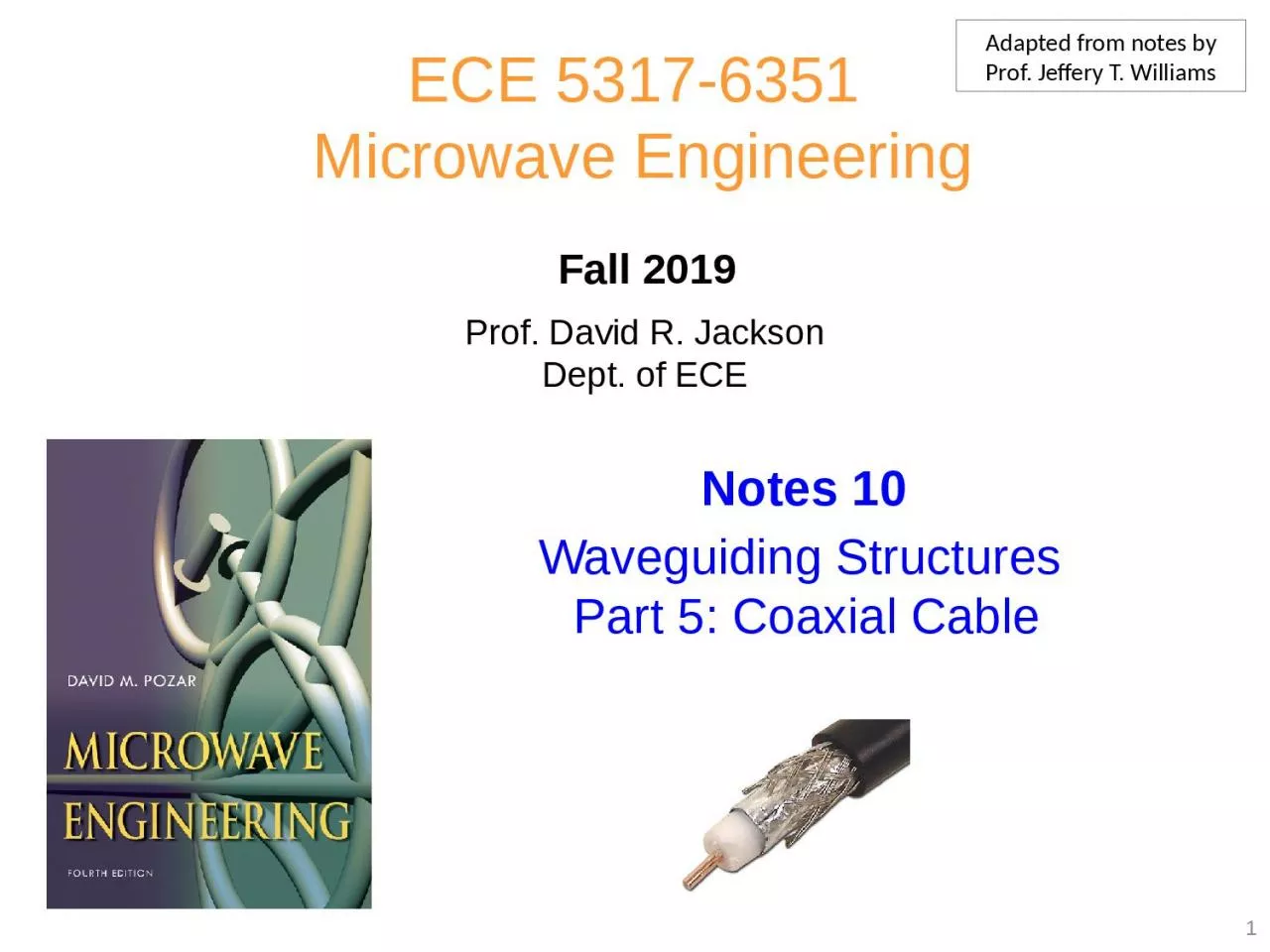

Notes 10 ECE 53176351 Microwave Engineering Fall 2019 Waveguiding Structures Part 5 Coaxial Cable 1 Adapted from notes by Prof Jeffery T Williams 2 TEM Solution Process A Solve Laplaces equation subject ID: 1038540
Download Presentation The PPT/PDF document "Prof. David R. Jackson Dept. of ECE" is the property of its rightful owner. Permission is granted to download and print the materials on this web site for personal, non-commercial use only, and to display it on your personal computer provided you do not modify the materials and that you retain all copyright notices contained in the materials. By downloading content from our website, you accept the terms of this agreement.
1. Prof. David R. JacksonDept. of ECENotes 10ECE 5317-6351 Microwave EngineeringFall 2019Waveguiding Structures Part 5: Coaxial Cable1Adapted from notes by Prof. Jeffery T. Williams
2. 2TEM Solution ProcessA) Solve Laplace’s equation subject to appropriate B.C.s.:B) Find the transverse electric field:C) Find the total electric field: D) Find the magnetic field:Note: The only frequency dependence is in the wavenumber kz = k.
3. To find the TEM mode fields, we need to solve:Here 0 = zero volt potential reference location (0 = b). Coaxial Line: TEM Mode3Assume wave going in +z direction.
4. Thus,Coaxial Line: TEM Mode (cont.)Hence4
5. Coaxial Line: TEM Mode (cont.)HenceNote: This formula does not account for conductor loss.5
6. Attenuation:Dielectric attenuation:6Coaxial Line: TEM Mode (cont.)Geometry for dielectric attenuation
7. Attenuation:Conductor attenuation:7(We assume Z0 is real here.)Coaxial Line: TEM Mode (cont.)Geometry for conductor attenuation(We ignore dielectric loss here.)
8. Conductor attenuation:8Coaxial Line: TEM Mode (cont.)(Here denotes the conductivity of the metal.)Geometry for conductor attenuation
9. Conductor attenuation:Hence we haveor9Coaxial Line: TEM Mode (cont.)Geometry for conductor attenuation
10. Let’s redo the calculation of conductor attenuation using the Wheeler incremental inductance formula.Wheeler’s formula:In this formula, dl (for a given conductor) is the distance by which the conducting boundary is receded away from the field region.The formula is applied for each conductor and the conductor attenuation from each of the two conductors is then added.10Coaxial Line: TEM Mode (cont.)Geometry for conductor attenuation
11. Hencesoor11Coaxial Line: TEM Mode (cont.)Geometry for conductor attenuation
12. whereWe can also calculate the fundamental per-unit-length parameters of the lossy coaxial line. From previous calculations:12(From Notes 3)Coaxial Line: TEM Mode (cont.)(From Notes 7)The “lossless” superscript means that we ignore all loss.
13. 13FrequencyRG59 Coax1 [MHz]0.0110 [MHz]0.03100 [MHz]0.111 [GHz]0.405 [GHz]1.010 [GHz]1.520 [GHz]2.350 [GHz]OM*100 [GHz]OM*Attenuation for RG59 CoaxApproximate attenuation in dB/m*OM = overmoded(from Wikipedia)
14. Coaxial Line: Power Flow14Power flow at z = 0:Note: At dielectric breakdown(Z0 is assumed to be real here.)
15. Coaxial Line: Higher-Order ModesWe look at the higher-order modes* of a coaxial line. 15The lowest waveguide mode is the TE11 mode. Sketch of field lines for TE11 mode*Here the term “higher-order modes” means the waveguide modes that exist in addition to the desired TEM mode.
16. Coaxial Line: Higher-Order Modes (cont.)TEz:16The solution in cylindrical coordinates is:Note: The value n must be an integer to have unique fields. eigenvalue problem
17. Plot of Bessel Functions17xJn (x)n = 0n = 1n = 2
18. Plot of Bessel Functions (cont.)18xYn (x)n = 0n = 1n = 2
19. 19We choose (somewhat arbitrarily) the cosine function for the angle variation. Wave traveling in +z direction:The cosine choice corresponds to having the transverse electric field E being an even function of, which is the field that would be excited by a probe located at = 0.Coaxial Line: Higher-Order Modes (cont.)
20. 20Boundary Conditions:HenceNote: The prime denotes derivative with respect to the argument.Coaxial Line: Higher-Order Modes (cont.)(From Ampere’s law)
21. 21HenceIn order for this homogenous system of equations for the unknowns A and B to have a non-trivial solution, we require the determinant to be zero.Coaxial Line: Higher-Order Modes (cont.)
22. 22DenoteFor a given choice of n and a given value of b/a, we can solve the above equation for x to find the zeros. Then we have:Coaxial Line: Higher-Order Modes (cont.)
23. 23A graph of the determinant reveals the zeros of the determinant.Note: These values are not the same as those of the circular waveguide, although the same notation for the zeros is being used.Coaxial Line: Higher-Order Modes (cont.)TE11 mode:
24. 24Figure 3.16 from the Pozar bookCoaxial Line: Higher-Order Modes (cont.)Exact solutionn = 1p = 1Approximate solution:The TE11 mode is the dominant higher-order mode of the coax (i.e., the waveguide mode with the lowest cutoff frequency).
25. Cutoff Frequency of TE11 Mode25TE11 mode of coax:Use formula on previous slideLossless case:
26. Coaxial Line: Lossless Case (cont.)26At the cutoff frequency, the wavelength (in the dielectric) is then:soCompare with the cutoff frequency condition of the TE10 mode of RWG:
27. Example27Example 3.3, p. 133 of the Pozar book:RG 142 coax: